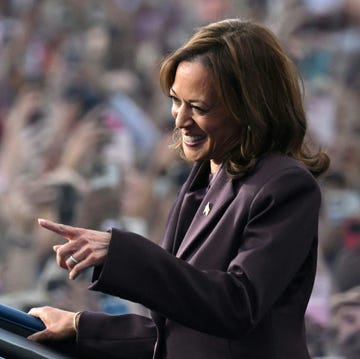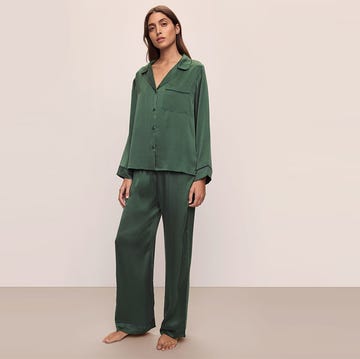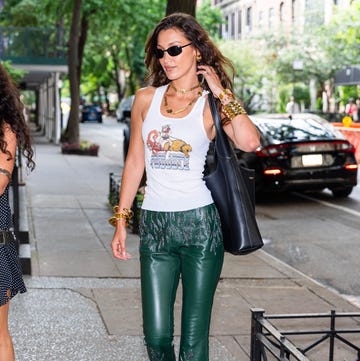It’s a hard time to be a London designer. The British economy is making for a cautious moment in a city where creativity is abundant but business opportunities are sadly not. Most designers decamp for creative directorships abroad, and very few find fortune making work in the Big Smoke. Nevertheless, the emerging talents showing during the first few days of London Fashion Week made an exciting case for the city’s fashion future and why it remains an important laboratory of ideas.
Friday’s S.S.Daley show, Steven Stokey-Daley’s first full womenswear offering, played with the tensions between hard and soft. Daley was particularly inspired by the 19th-century British artist Gluck, known for his picture-frame portraits and floral paintings. Daley transformed Gluck’s own tailored uniform into a black wool day coat, worn over a high-collar shirt and the signature roomy pants that made the designer a hit in 2020. Florals bloomed on bias-cut slipdresses, oversize shirting, and a ripstop trench that appeared manipulated due to the weaving process and was trimmed in ecru leather. While a lot of the chatter from the show came from Harry Styles’s impromptu attendance (Styles is also an investor in S.S.Daley), the buzz is warranted for Daley’s Spring/Summer ’25, a confident collection that tied together his point of view for British craft and culture with the signature design codes he’s been establishing since the start.
Elsewhere, Emma Chopova and Laura Lowena-Irons grounded themselves in the unorthodox beauty and creative chaos that make their label Chopova Lowena so beloved. The designers, who show only once a year, used the setting of a dormant town hall in the city’s Shoreditch area to present their “Chuckaboo” collection—a vision of “walloping womanity,” per the show notes; more simply, muses and female icons (think Annie Oakley and Calamity Jane) drawn from America’s Wild West. The garb of rodeo women and showgirls was translated into embellished denim. Black corsets were latched onto traditional floral Bulgarian textiles by carabiners (a Chopova Lowena signature since the brand’s start). Influences of Victorian-era ruffles—think bloomers and hip bustles—added freshness to a collection that felt the most universally wearable yet. It was as though the designers were encouraging us to choose our own adventure, with the clothes and attitude to match. Walt Yotka, 75-year-old father of Bazaar contributor Steff Yotka, appearing in the model mix with London’s It kids is a testament to the brand’s far-reaching appeal. The designers themselves echoed this sentiment, saying, “Every girl becomes a woman and must choose the costume she’ll wear for the world, reinventing herself every day in her wardrobe.”
Earlier this month, Standing Ground’s Michael Stewart was named the winner of the inaugural LVMH Savoir-Faire prize, which rewards craftsmanship and technical expertise, and is chosen by a cohort of LVMH creative directors that this year included Jonathan Anderson and Phoebe Philo. Saturday’s Standing Ground show doubled down on Stewart’s insistence on the details. His work has always been rooted in occasionwear—long column dresses with a gust of fabrics at the hip. A simplistic sexiness, but this season he incorporated elements of beading on miniskirts and leather-wrapped beads on cascading tops. There were also embellishments on the backs of floor-length jackets that felt more complex and daring—artifactual, even. Swooping silk dresses in red and ochre echoed a modern take on ancient togas. His clothes are currently made-to-order only—a bet on the appeal and rarity of his sort of talent.
Aaron Esh’s all-black rock ’n’ roll, leather-heavy collection did what London is known for, which is emphasizing a street couture that one could see on the cool kids in every major city. Richard Quinn brought his regal elegance and grandeur-ish ball gowns to one of London’s most fitting settings: the ballroom at the Dorchester. And Priya Ahluwalia continued her meditation on her Indian-Nigerian heritage in a collection titled “Home Sweet Home,” which picked up on the jumble of textiles and prints (wallpapers, curtains, rugs, doilies) prevalent in colorful immigrant homes.
All these designers presented distinctive ideas of British identities painting a colorful and creatively rich picture of London right now.
Lynette Nylander is the Executive Digital Director of Harper’s Bazaar. Originally from London, England, her great loves include reading, singing badly at karaoke, new shoes and Ru Paul’s Drag Race.















